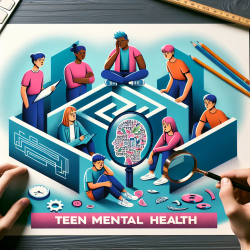Nonsuicidal self-injury (NSSI) among adolescents is a growing concern in educational settings. The recent study titled A Person-Centered Approach to Adolescent Nonsuicidal Self-Injury: Predictors and Correlates in a Community Sample provides valuable insights into the diverse patterns of NSSI behaviors among high school students. This blog aims to help practitioners apply these findings to improve their skills and encourage further research.
The Study's Approach and Findings
The study utilized Latent Class Analysis (LCA) to identify distinct subgroups of adolescents based on their engagement in various self-injury methods. Two primary classes emerged:
- Severe/Multimethod NSSI Class: Comprising 39% of participants, this group engaged in multiple severe forms of NSSI, such as cutting and biting, often driven by intrapersonal motivations like self-punishment and emotion regulation.
- Mild/Moderate NSSI Class: Making up 61% of the sample, these adolescents engaged in less severe forms of NSSI with lower frequency.
The study highlights that adolescents in the Severe/Multimethod class are at greater risk for poor mental health outcomes, including lower subjective well-being and higher perfectionistic concerns. These findings underscore the importance of identifying at-risk students early to prevent the escalation of NSSI behaviors.
Implications for Practitioners
Practitioners can leverage these insights by adopting a person-centered approach in their interventions. Here are some strategies to consider:
- Early Identification: Use screening tools to identify students who exhibit signs of severe NSSI behaviors. Early intervention can help mitigate long-term mental health issues.
- Address Intrapersonal Motivations: Develop therapeutic interventions that focus on reducing self-critical perfectionism and improving emotional regulation skills.
- Enhance Well-being: Incorporate positive psychology techniques to boost emotional, psychological, and social well-being among students.
- Tailored Interventions: Customize interventions based on the severity and type of NSSI behaviors, ensuring that they address specific intrapersonal and interpersonal motivations.
Encouraging Further Research
The study opens avenues for further research into the developmental trajectories of NSSI behaviors. Longitudinal studies could provide deeper insights into how adolescents transition between different classes over time and what factors contribute to these shifts.
Practitioners are encouraged to stay informed about ongoing research and consider collaborating with academic institutions to contribute to this field. By doing so, they can enhance their understanding and improve outcomes for adolescents struggling with NSSI.
To read the original research paper, please follow this link: A Person-Centered Approach to Adolescent Nonsuicidal Self-Injury: Predictors and Correlates in a Community Sample.










